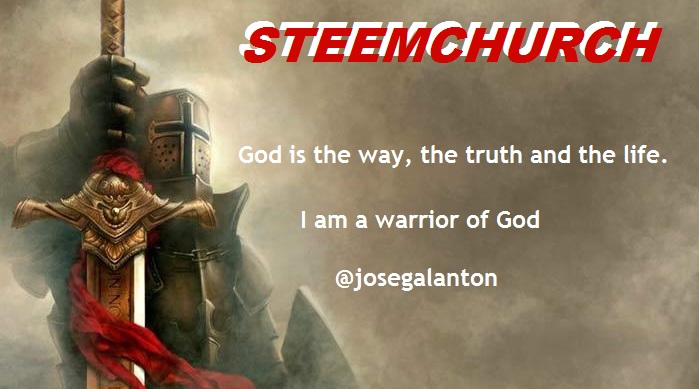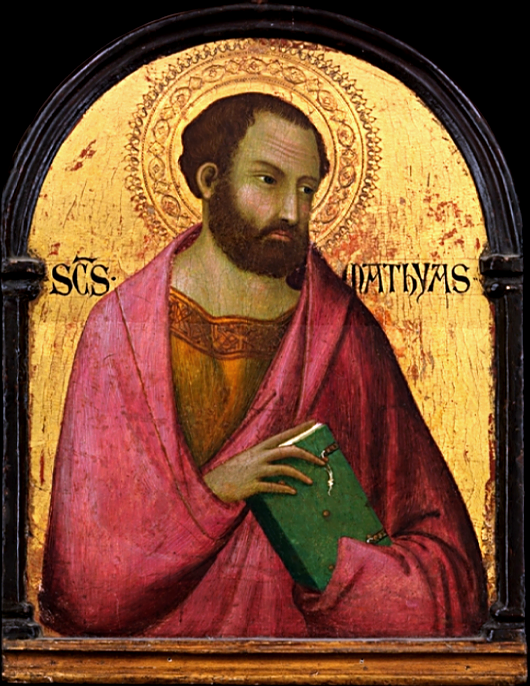STEEMCHURCH | The 13 apostle; Matias Gift of God (apostle)
The Apostle Matias
This is the Apostle No. 13. He is a "posthumous" apostle (Posthumous is called the one who appears after the death of another). Matías was chosen "apostle" by the other 11, after the death and Ascension of Jesus, to replace Judas Iscariote who hanged himself. The S. Bible narrates in the following way its election:
"After the Ascension of Jesus, Peter said to the other disciples: Brothers, in Judas what was said of him in the Holy Scripture was fulfilled: with the price of his wickedness he bought himself a field. , he burst through and all his bowels were spilled, the field purchased with his 30 coins was called Haceldama, which means "Field of blood." Psalm 69 says: "his position is left without anyone to occupy it, and his room is left. without who inhabits it, "and Psalm 109 commands:" Let another receive his charge. "
"It is convenient then that we choose one to replace Judas, and the chosen one must be of those who were with us all the time the Lord lived with us, since he was baptized by John the Baptist until he was resurrected and ascended into heaven" .
The disciples presented two candidates: José, son of Sabas and Matías. Then they prayed saying: "Lord, you who know the hearts of all, show us which of these two you choose as an apostle, to replace Judas."
They cast lots and luck fell on Matthias and was admitted from that day on the number of the twelve apostles (Acts of the Apostles).

Why choose a 13 apostle?
At the death of Jesus, and a few days after the Ascension, St. Peter gathered together with the Christian community (about 120 souls) in Jerusalem, explaining that, as foreseen in the Scriptures (Psalm 69:25), one of the Apostles had prevaricated (prevarication) (Acts 1: 17-25), and that another was to replace him: "Let your days be few, let another take his office" (Psalm 109: 8); therefore, an election was imposed. Two names were proposed: "Joseph, by the nickname Barsaba, called Just, and Matthias." A prayer addressed to the Lord was pronounced so that it would manifest its will about the election of the new Apostle, as it did with the first Twelve (Mk 3,13-19, par.), And it was left to the procedure of the lots, current already in the Old Testament (cf. 7,14,16; 14,2; 1,7), the manifestation of that will. This was that the vacancy of Judas covered Matías.
Why was it "necessary" to name one for the position of Judas? When Saint James the Great died towards him. (Acts 12.2) no one was named in his place, nor was Paul of Tarsus considered his substitute. The "Twelve Apostles" chosen by Jesus are for the present and for the future, when they "judge (as new" twelve "patriarchs) the twelve tribes of Israel" (Mt 19,28; Le 22,31); and by their number they express a fullness that, in this case, represents the fullness of the People of God. For the first reason, Santiago did not leave a vacancy when he died, he did not finish his apostolate; whereas the betrayal of Judas and his death without effective repentance were interpreted as a desertion, a "turning away" (parabainein, Acts 1.25), (leaving his place deserted). The need for a new Apostle was born not from the death of Judas but from his desertion. For the second reason, it was necessary to complete the number of "twelve."

How they chose the Apostle Matías
St. Matthias can be called a "gray apostle," who did not shine in a special way, but who was like so many of us, a disciple of the heap, like an ant in an anthill. And many of us are encouraged to have saints like that because that is going to be our holiness: the sanctity of ordinary people. And of these saints, the sky is full: San Truck Driver and Santa Costurera. San Bulk Charger and Santa Laundress for clothes. Saint Bricklayer and Santa Warehouse Salesman, Saint Employee and Holy Secretary, etc. This greatly democratizes holiness, because it is no longer for brilliant characters only, but for us in the heap, as long as we fulfill our own duties every day and always for the love of God and with much love for God.
San Clemente and San Jerónimo say that San Matías had been one of the 72 disciples that Jesus sent once to mission, two at a time. An old tradition tells that he dead crucifed. They paint it with a wooden cross in their hand and the carpenters have special devotion.

It is said that the relics of Matthias were, by order of St. Helena, taken to Trier, where his tomb is venerated in the abbey dedicated to the Saint. There are also relics in Rome (Santa Maria Maggiore) and in Padua (Santa Justina), also in the church of San Pedro in Lima, Peru. It is also patron of butchers and architects.
His party is celebrated in the Latin church on May 14; in the Balearics and Aragon on February 24, and in the Greek church, on August 9.


Why choose a 13 apostle?
At the death of Jesus, and a few days after the Ascension, St. Peter gathered together with the Christian community (about 120 souls) in Jerusalem, explaining that, as foreseen in the Scriptures (Psalm 69:25), one of the Apostles had prevaricated (prevarication) (Acts 1: 17-25), and that another was to replace him: "Let your days be few, let another take his office" (Psalm 109: 8); therefore, an election was imposed. Two names were proposed: "Joseph, by the nickname Barsaba, called Just, and Matthias." A prayer addressed to the Lord was pronounced so that it would manifest its will about the election of the new Apostle, as it did with the first Twelve (Mk 3,13-19, par.), And it was left to the procedure of the lots, current already in the Old Testament (cf. 7,14,16; 14,2; 1,7), the manifestation of that will. This was that the vacancy of Judas covered Matías.
Why was it "necessary" to name one for the position of Judas? When Saint James the Great died towards him. (Acts 12.2) no one was named in his place, nor was Paul of Tarsus considered his substitute. The "Twelve Apostles" chosen by Jesus are for the present and for the future, when they "judge (as new" twelve "patriarchs) the twelve tribes of Israel" (Mt 19,28; Le 22,31); and by their number they express a fullness that, in this case, represents the fullness of the People of God. For the first reason, Santiago did not leave a vacancy when he died, he did not finish his apostolate; whereas the betrayal of Judas and his death without effective repentance were interpreted as a desertion, a "turning away" (parabainein, Acts 1.25), (leaving his place deserted). The need for a new Apostle was born not from the death of Judas but from his desertion. For the second reason, it was necessary to complete the number of "twelve."

How they chose the Apostle Matías
St. Matthias can be called a "gray apostle," who did not shine in a special way, but who was like so many of us, a disciple of the heap, like an ant in an anthill. And many of us are encouraged to have saints like that because that is going to be our holiness: the sanctity of ordinary people. And of these saints, the sky is full: San Truck Driver and Santa Costurera. San Bulk Charger and Santa Laundress for clothes. Saint Bricklayer and Santa Warehouse Salesman, Saint Employee and Holy Secretary, etc. This greatly democratizes holiness, because it is no longer for brilliant characters only, but for us in the heap, as long as we fulfill our own duties every day and always for the love of God and with much love for God.
San Clemente and San Jerónimo say that San Matías had been one of the 72 disciples that Jesus sent once to mission, two at a time. An old tradition tells that he dead crucifed. They paint it with a wooden cross in their hand and the carpenters have special devotion.

It is said that the relics of Matthias were, by order of St. Helena, taken to Trier, where his tomb is venerated in the abbey dedicated to the Saint. There are also relics in Rome (Santa Maria Maggiore) and in Padua (Santa Justina), also in the church of San Pedro in Lima, Peru. It is also patron of butchers and architects.
His party is celebrated in the Latin church on May 14; in the Balearics and Aragon on February 24, and in the Greek church, on August 9.


How they chose the Apostle Matías
St. Matthias can be called a "gray apostle," who did not shine in a special way, but who was like so many of us, a disciple of the heap, like an ant in an anthill. And many of us are encouraged to have saints like that because that is going to be our holiness: the sanctity of ordinary people. And of these saints, the sky is full: San Truck Driver and Santa Costurera. San Bulk Charger and Santa Laundress for clothes. Saint Bricklayer and Santa Warehouse Salesman, Saint Employee and Holy Secretary, etc. This greatly democratizes holiness, because it is no longer for brilliant characters only, but for us in the heap, as long as we fulfill our own duties every day and always for the love of God and with much love for God.
San Clemente and San Jerónimo say that San Matías had been one of the 72 disciples that Jesus sent once to mission, two at a time. An old tradition tells that he dead crucifed. They paint it with a wooden cross in their hand and the carpenters have special devotion.

It is said that the relics of Matthias were, by order of St. Helena, taken to Trier, where his tomb is venerated in the abbey dedicated to the Saint. There are also relics in Rome (Santa Maria Maggiore) and in Padua (Santa Justina), also in the church of San Pedro in Lima, Peru. It is also patron of butchers and architects.
His party is celebrated in the Latin church on May 14; in the Balearics and Aragon on February 24, and in the Greek church, on August 9.


It is said that the relics of Matthias were, by order of St. Helena, taken to Trier, where his tomb is venerated in the abbey dedicated to the Saint. There are also relics in Rome (Santa Maria Maggiore) and in Padua (Santa Justina), also in the church of San Pedro in Lima, Peru. It is also patron of butchers and architects. His party is celebrated in the Latin church on May 14; in the Balearics and Aragon on February 24, and in the Greek church, on August 9.

Excellent story I see you know the story well